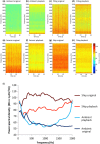Repeated exposure reduces the response to impulsive noise in European seabass
- PMID: 27282635
- PMCID: PMC5006868
- DOI: 10.1111/gcb.13352
Repeated exposure reduces the response to impulsive noise in European seabass
Abstract
Human activities have changed the acoustic environment of many terrestrial and aquatic ecosystems around the globe. Mounting evidence indicates that the resulting anthropogenic noise can impact the behaviour and physiology of at least some species in a range of taxa. However, the majority of experimental studies have considered only immediate responses to single, relatively short-term noise events. Repeated exposure to noise could lead to a heightened or lessened response. Here, we conduct two long-term (12 week), laboratory-based exposure experiments with European seabass (Dicentrarchus labrax) to examine how an initial impact of different sound types potentially changes over time. Naïve fish showed elevated ventilation rates, indicating heightened stress, in response to impulsive additional noise (playbacks of recordings of pile-driving and seismic surveys), but not to a more continuous additional noise source (playbacks of recordings of ship passes). However, fish exposed to playbacks of pile-driving or seismic noise for 12 weeks no longer responded with an elevated ventilation rate to the same noise type. Fish exposed long-term to playback of pile-driving noise also no longer responded to short-term playback of seismic noise. The lessened response after repeated exposure, likely driven by increased tolerance or a change in hearing threshold, helps explain why fish that experienced 12 weeks of impulsive noise showed no differences in stress, growth or mortality compared to those reared with exposure to ambient-noise playback. Considering how responses to anthropogenic noise change with repeated exposure is important both when assessing likely fitness consequences and the need for mitigation measures.
Keywords: Dicentrarchus labrax; European seabass; anthropogenic noise; growth; habituation; hearing threshold; pollution; stress; tolerance; ventilation rate.
© 2016 The Authors. Global Change Biology Published by John Wiley & Sons Ltd.
Figures



Similar articles
-
Anthropogenic noise pollution from pile-driving disrupts the structure and dynamics of fish shoals.Proc Biol Sci. 2017 Sep 27;284(1863):20171627. doi: 10.1098/rspb.2017.1627. Proc Biol Sci. 2017. PMID: 28954915 Free PMC article.
-
Anthropogenic noise compromises the anti-predator behaviour of the European seabass, Dicentrarchus labrax (L.).Mar Pollut Bull. 2017 Sep 15;122(1-2):297-305. doi: 10.1016/j.marpolbul.2017.06.067. Epub 2017 Jun 26. Mar Pollut Bull. 2017. PMID: 28662977
-
European seabass respond more strongly to noise exposure at night and habituate over repeated trials of sound exposure.Environ Pollut. 2018 Aug;239:367-374. doi: 10.1016/j.envpol.2018.04.018. Epub 2018 Apr 16. Environ Pollut. 2018. PMID: 29674215
-
A critical review of the potential impacts of marine seismic surveys on fish & invertebrates.Mar Pollut Bull. 2017 Jan 15;114(1):9-24. doi: 10.1016/j.marpolbul.2016.11.038. Epub 2016 Dec 6. Mar Pollut Bull. 2017. PMID: 27931868 Review.
-
A noisy spring: the impact of globally rising underwater sound levels on fish.Trends Ecol Evol. 2010 Jul;25(7):419-27. doi: 10.1016/j.tree.2010.04.005. Epub 2010 May 17. Trends Ecol Evol. 2010. PMID: 20483503 Review.
Cited by
-
An overview of fish bioacoustics and the impacts of anthropogenic sounds on fishes.J Fish Biol. 2019 May;94(5):692-713. doi: 10.1111/jfb.13948. Epub 2019 Apr 5. J Fish Biol. 2019. PMID: 30864159 Free PMC article. Review.
-
Developmental experience with anthropogenic noise hinders adult mate location in an acoustically signalling invertebrate.Biol Lett. 2018 Feb;14(2):20170714. doi: 10.1098/rsbl.2017.0714. Biol Lett. 2018. PMID: 29491025 Free PMC article.
-
Motorboat noise disrupts co-operative interspecific interactions.Sci Rep. 2017 Aug 1;7(1):6987. doi: 10.1038/s41598-017-06515-2. Sci Rep. 2017. PMID: 28765626 Free PMC article.
-
Pile driving repeatedly impacts the giant scallop (Placopecten magellanicus).Sci Rep. 2022 Sep 13;12(1):15380. doi: 10.1038/s41598-022-19838-6. Sci Rep. 2022. PMID: 36100686 Free PMC article.
-
Limiting motorboat noise on coral reefs boosts fish reproductive success.Nat Commun. 2022 May 20;13(1):2822. doi: 10.1038/s41467-022-30332-5. Nat Commun. 2022. PMID: 35595750 Free PMC article.
References
-
- Anderson PA, Berzins IK, Fogarty F, Hamlin HJ, Guillette LJ Jr (2011) Sound, stress, and seahorses: the consequences of a noisy environment to animal health. Aquaculture, 311, 129–138.
-
- Andrew RK, Howe BM, Mercer JA (2011) Long‐time trends in ship traffic noise for four sites off the North American West Coast. Journal of the Acoustical Society of America, 129, 642–651. - PubMed
-
- Barber JR, Crooks KR, Fristrup KM (2009) The costs of chronic noise exposure for terrestrial organisms. Trends in Ecology and Evolution, 25, 180–189. - PubMed
-
- Barton BA (2002) Stress in fishes: a diversity of responses with particular reference to changes in circulating corticosteroids. Integrative and Comparative Biology, 42, 517–525. - PubMed
-
- Beale CM, Monaghan P (2004) Behavioural responses to human disturbance: a matter of choice? Animal Behaviour, 68, 1065–1069.
MeSH terms
LinkOut - more resources
Full Text Sources
Other Literature Sources
Molecular Biology Databases

